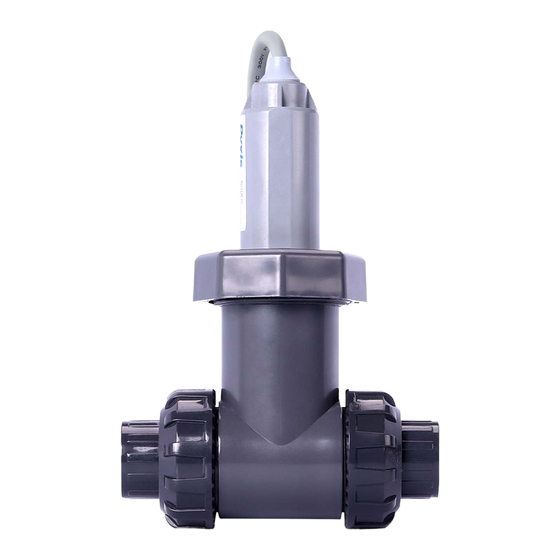
Pyxis ST-735 Operation Manual
Inline turbidity/sludge concentration sensor
Hide thumbs
Also See for ST-735:
- User manual (20 pages) ,
- Quick start manual (2 pages) ,
- User manual (17 pages)
Summary of Contents for Pyxis ST-735
- Page 1 ST-735 Inline Turbidity/Sludge Concentration Sensor Operation Manual Version 1.1 December 2018...
-
Page 2: Table Of Contents
6.8. Zero Calibration 6.9. Slope Calibration (Low Range) 6.10. Slope Calibration (Mid Range) 6.11. Slope Calibration (High Range) 6.12. 4-20 mA Span 7. Communicating Using Modbus RTU 8. Probe Cleaning and Maintenance 8.1. ST-735 Inline Probe Cleaning Solution 9. Storage... -
Page 3: Introduction
Pyxis MA-102S submersion adapter. The ST-735 measures light scattering for the 0 – 100 NTU range using a white LED as the incident light source, the 100 – 1000 NTU range using a 950 nm LED light source, and the 950 nm absorbance for the 1000 –... -
Page 4: Optional Accessories
Regulatory: CE Marked Installation The ST-735 probe comes with a custom-made ST-001 tee with ¾” FNPT inlet and outlet and quick unions. Place the O-ring to the probe and insert the probe into the tee. Make sure that the fluidic channel in the probe is aligned with the sample flow direction. -
Page 5: Quick 4-20Ma Start
4-20 mA negative terminal in the controller. If a separate DC power supplier other than that from the controller is used, make sure that the output from the power supply is rated for 22-26 VDC @ 65mA. Follow the wiring table below to connect the ST-735 probe to a controller. Wire Color... -
Page 6: Connect Via Wi-Fi/Bluetooth
Connect via Wi-Fi/Bluetooth Figure 3 shows the connection between a computer and the ST-735 probe via Wi-Fi/Bluetooth adapter (P/N: MA-WB). A smart phone app is provided to connect the ST-735 probe to your smart phone via Wi- Fi/Bluetooth interface. 4.3. -
Page 7: Probe Calibration With Upyxis Mobile App
Google Play 5.2. Connecting to uPyxis Mobile App Turn on Bluetooth on your mobile phone (Do not pair the phone Bluetooth to the ST-735). Open uPyxis Mobile App. uPyxis App connects to the Probe and click on the ST-735 probe. -
Page 8: Diagnosis Screen
5.3. Diagnosis Screen From the Diagnosis screen. You can check the diagnosis condition, and Export & Upload. 5.4. Calibration Screen and Reading When connected, Mobile App will default to the Calibration screen. From the Calibration screen you can perform calibrations by pressing on Zero Calibration, Low Range... -
Page 9: Device Screen
5.5. Device Info Screen From the Device Info screen. You can name the Device or Product. Probe Calibration with uPyxis Desktop App 6.1. Download uPyxis Desktop App Download uPyxis Desktop App from https://pyxis-lab.com/support-2/... -
Page 10: Unzip Upyxis Desktop App
6.2. UnZip uPyxis Desktop App Find your downloaded uPyxis Setup 1.3.8 file, Right Click on the file, Extract All, and then Extract. -
Page 11: Installing Upyxis Desktop App
6.3. Installing uPyxis Desktop App Once the uPyxis Desktop App has been extracted. Find the extracted uPyxis Setup file and left click, click on Run, and then click Install. After install has been clicked the Setup Progress will continue. Follow the step during installation process. -
Page 12: Connecting Upyxis Desktop App
6.4. Connecting to uPyxis Desktop App Open uPyxis Desktop App on your desktop. When the desktop app opens, to find your device, click on Device, then Connect via Wi-Fi. -
Page 13: Connecting To Device
6.5. Connecting to Device When connected via USB-Bluetooth, in the Device List a picture of the probe with the serial number will appear (If no device is found, remove the USB/Bluetooth dongle and reconnect). If device shows in the Device List, then the probe is connected. Once connected to the probe, the default main screen is the Information screen. -
Page 14: Calibrating Device
6.7. Calibrating Device To calibrate the device, click on Calibration. On the Calibration screen there are three calibration tabs, Zero Calibration, Slope Calibration, and 4-20 mA Span. The screen does also display the reading of the device. The reading refreshed rate is every 4 seconds. -
Page 15: Zero Calibration
6.8. Zero Calibration To perform Zero Calibration, click on Zero Calibration. Then follow the instruction on how to calibrate, then click Ok. -
Page 16: Slope Calibration (Low Range)
6.9. Slope Calibration (Low Range) To perform Slope Calibration (Low Range), click on Slope Calibration (Low Range). Then follow the instruction on how to calibrate, then click Slope Calibration. -
Page 17: Slope Calibration (Mid Range)
6.10. Slope Calibration (Mid Range) To perform Slope Calibration (Mid Range), click on Slope Calibration (Mid Range). Then follow the instruction on how to calibrate, then click Slope Calibration. -
Page 18: Slope Calibration (High Range)
6.11. Slope Calibration (High Range) To perform Slope Calibration (High Range), click on Slope Calibration (High Range). Then follow the instruction on how to calibrate, then click Slope Calibration. -
Page 19: Ma Span
Slope Calibration. 7. Communicating using Modbus RTU The ST-735 probe is configured as a Modbus slave device. In addition to the NTU value, many operational parameters, including warning and error messages, are available via a Modbus RTU connection. Contact Pyxis Lab Customer Service (service@pyxis-lab.com) for more information. -
Page 20: Probe Cleaning And Maintenance
8. Probe Cleaning and Maintenance The flow channel of the ST-735 should be cleaned once a month using a soft brush. Deposit and debris should be removed. The probe can be cleaned with our hand held clean solution (https://pyxis- lab.com/product/st-500-probe-cleaning-kit/). Do not use organic solvents or strong acid base to clean the probe.















Need help?
Do you have a question about the ST-735 and is the answer not in the manual?
Questions and answers